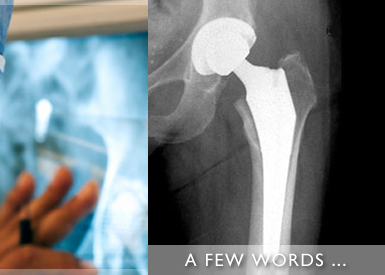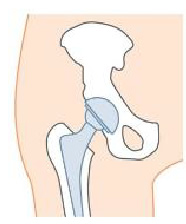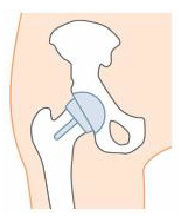|
Hip Resurfacing is a good technique for younger more active patients where bone conservation and a large metal on metal articulation is required. The mid head resection resurfacing (BMHR) is a variation appropriate for patients with conditions like osteonecrosis and Perthe's disease. |
A SOLUTION FOR YOUNG AND ACTIVE PATIENTS You are considering a total hip replacement to minimise your pain and discomfort and improve your quality of life. Hip resurfacing is a technique designed to reline rather than replace the worn hip joint.
The Durom® Hip Resurfacing System is in particular suited for young, active patients who wish to return to an active lifestyle following their operation. THE HIP
The natural hip is a ball and socket joint. The head of the femur (thighbone) moves in a socket in the pelvis called the acetabulum. The joint is held together by tendons, ligaments and muscles. When the hip joint wears out it is called osteoarthritis. An osteoarthritic hip is usually stiff and painful. One possible treatment is the replacement of the hip with an implant. A total hip replacement is the standard operation for an osteoarthritic hip. During a hip replacement the head and neck of the femur are removed. A cavity 15-20 cm long is then made in the shaft of the femur and a metal stem inserted. A cup is then placed into the socket which has been reamed to shape. Both components are held in place by either bone in-growth or with polymer cement.
In hip resurfacing, the hip joint is relined rather than replaced. The head and neck of the femur are preserved. The worn surfaces of the head and socket are carefully machined away with precision instruments. The joint is then lined with a metal covering for the head and socket. HIP RESURFACING
The hip resurfacing implant has three key advantages:
- Bone conservation - Low wear bearing - Anatomic sized bearing
BONE CONSERVATION One of the major problems of revision hip surgery (where a worn out or loose hip implant has to be changed to another one) is the loss of bone which necessitates the use of larger and longer hip stems. In hip resurfacing the head and neck are preserved. The worn surface and only 3–4 mm of bone below it are removed. This allows the patients to keep as much of their own hip as possible for as long as possible. Therefore if the resurfacing should fail for any reason the head and neck can be removed and a standard total hip replacement can be performed. LOW WEAR BEARING One of the major advantages of hip resurfacing is the metal-on-metal bearing. The precision-engineered components are made of a hard, biocompatible alloy (which consists mainly of cobalt and chromium) which produces very low rates of wear. The bearing used in Durom Hip Resurfacing is known as Metasul® Metal-on-Metal Tribological Solution. The Metasul bearing has been in clinical use since 1988 and over 250,000 hips with these bearings have been implanted worldwide. ANATOMIC SIZED BEARING In a resurfaced hip the femoral head is similar in size to the natural hip. In conventional total hip replacement the average head size is smaller than the natural hip. The advantage of a larger head size is a greater range of movement of the hip and increased stability, in other words less chance of it coming out of joint (dislocating). THE OPERATION: BEFORE AND AFTER SURGERY The details of the operation will be discussed with your orthopaedic surgeon in detail prior to the operation itself. However, in general, your treatment will progress along the following lines. Preliminary tests will be needed a few weeks in advance of the surgery to determine whether you are ready for surgery and whether any special precautions may be required. The risk associated with hip resurfacing surgery is similar to that of a conventional operation; the same is true with regard to the risk of complications. The incision for a hip surface replacement may be little longer than that required for a conventional hip joint replacement although the procedure should take a similar amount of time. In most cases, the post-surgery recovery time is shorter than for a conventional hip replacement. In the first few weeks after the operation, you will take part in a rehabilitation programme. You will be advised on post-surgery activities by your orthopaedic surgeon but usually patients will be able to climb stairs again soon with the use of a walking aid. Generally speaking, you should be relatively independent after about 11⁄2 months and, about 3 months after surgery, most patients return to everyday activities. Many patients consider themselves cured after about one year. CAN YOUR HIP BE RESURFACED? This is dependant on your age, medical conditions and the X-rays of your hip. Your orthopaedic surgeon will advise you as to whether your hip can be resurfaced. Individual results may vary. Your results will depend upon your personal circumstances. This information is intended to provide an overview of hip resurfacing surgery. Review this information with your doctor. |
||




